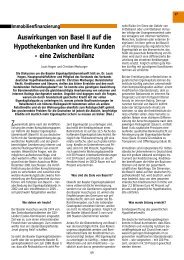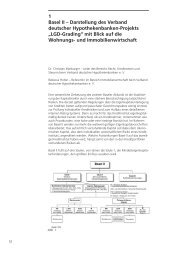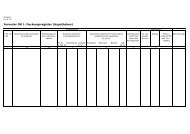Expected Loss Covered Bond Model
Expected Loss Covered Bond Model
Expected Loss Covered Bond Model
Create successful ePaper yourself
Turn your PDF publications into a flip-book with our unique Google optimized e-Paper software.
APPENDIX C1: DEFINING AND CALCULATING THE COLLATERAL SCORE<br />
One of the key inputs into Moody’s EL <strong>Model</strong> is the credit quality of the Cover Pool. The Cover Pool credit quality<br />
will be assessed as part of Moody’s analysis, and a score (“Collateral Score”) calculated and determined based on<br />
a number of assumptions and considerations. The better is the credit quality of the Cover Pool, the lower will be<br />
the Collateral Score.<br />
The Collateral Score is calculated by Moody’s using techniques routinely used in structured finance transactions.<br />
The method of calculation will vary depending on the type of collateral in the Cover Pool, and also the jurisdiction<br />
or market in which it is located. 8<br />
The Collateral Score can be seen as a representation of how much risk-free credit enhancement may be required<br />
to protect the Aaa rating of the <strong>Covered</strong> <strong>Bond</strong>s against a credit deterioration of the assets in the Cover Pool.<br />
Limiting the analysis to the credit deterioration of the assets in the Cover Pool means that:<br />
• There is no support from Issuer and Issuer group;<br />
• No forced sale is required to make timely payments on the <strong>Covered</strong> <strong>Bond</strong>s (i.e. the assets in the Cover<br />
Pool are allowed to amortise naturally over their term); and<br />
• There are no market risks between assets and liabilities (i.e. no mismatches between the underlying<br />
collateral in the Cover Pool and the <strong>Covered</strong> <strong>Bond</strong>s).<br />
So, for example, assuming that the risk-free credit enhancement required for such a Cover Pool to achieve a Aaa<br />
rating is 5%, the Collateral Score would be 5%. The higher the credit quality of the Cover Pool, the lower the riskfree<br />
enhancement required to protect against a credit deterioration of the assets and therefore the lower the<br />
Collateral Score.<br />
The rank-ordering of Collateral Scores between different asset types will typically be as follows (ranging from<br />
Collateral Scores of highest credit quality to lowest credit quality).<br />
• Public sector obligations.<br />
• Residential mortgages.<br />
• Commercial mortgages.<br />
However:<br />
• Cover Pools made up of high-quality residential mortgages may have a Collateral Score which is lower<br />
than that for a Cover Pool made up of public sector obligations; and<br />
• Cover Pools made up of high-quality commercial mortgages may have a Collateral Score which is lower<br />
than that for a Cover Pool of residential mortgages.<br />
Each transaction and asset type (and, where applicable, each jurisdiction and market) will be considered on its<br />
own merits and a Collateral Score determined accordingly.<br />
8<br />
Moody’s has published a number of methodology reports covering residential and commercial mortgages, and collateralised debt obligations.<br />
European <strong>Covered</strong> <strong>Bond</strong> Rating Methodology Moody’s Investors Service • 9

















